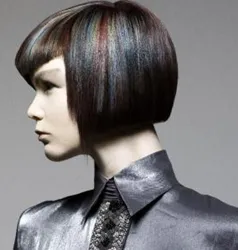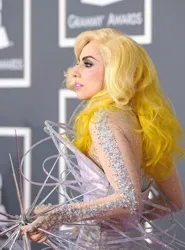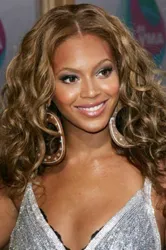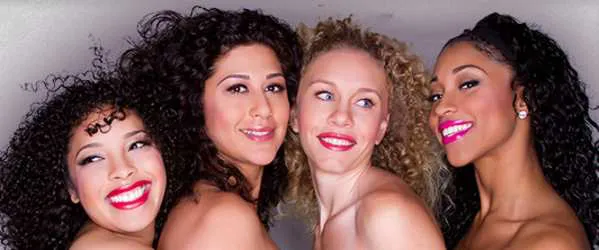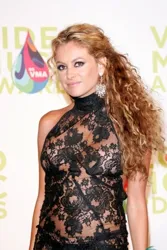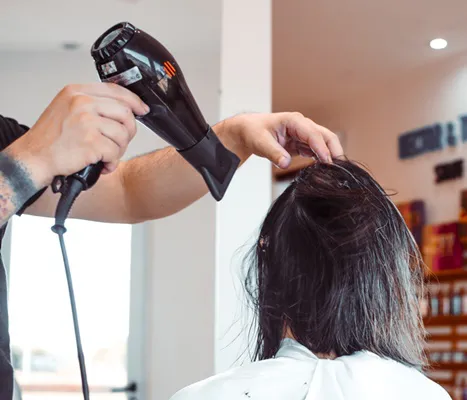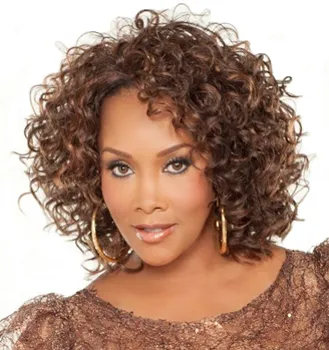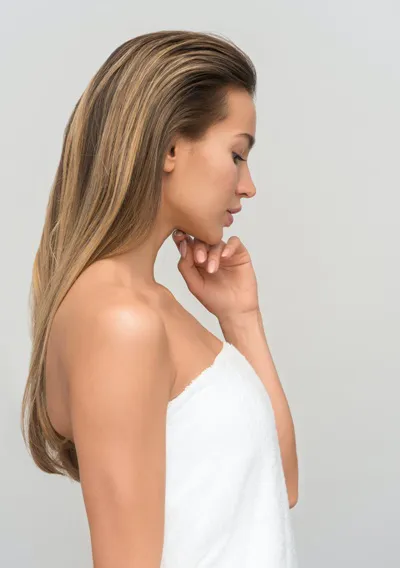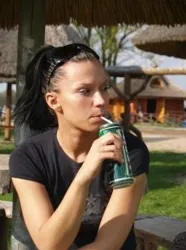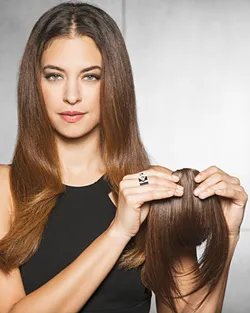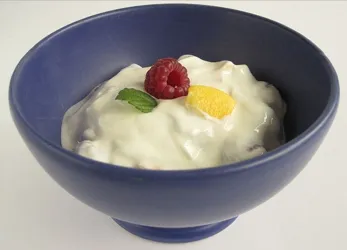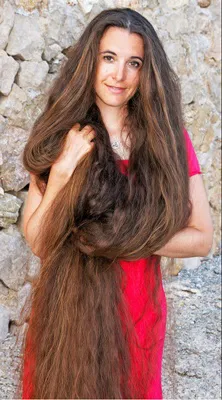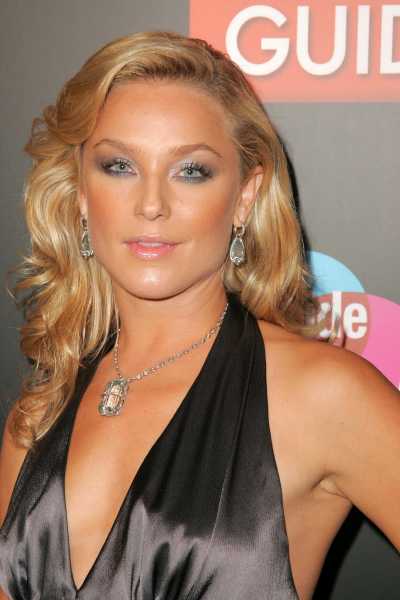Introduction 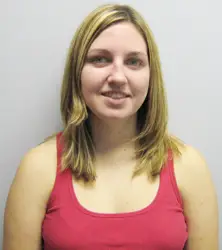 | | Brigid K. O'Connor Front View Before Individual Strand Heat Fusion Hair Extensions 09-13-07 | | HairBoutique.com All Rights Reserved. | Since HairBoutique.com was founded in late 1997 I have had the wonderful opportunity to learn many things about all types of hair. My own hair is naturally wavy with a slight amount of curl. I have discussed my own curls with a range of curl experts including Ouidad, known as the Queen of Curls, Lorraine Massey who wrote the extremely popular Curly Girl: More Than Just Hair bible and a wide range of celebrity stylists that have weighed in with their own thoughts. My AskKaren files are literally stuffed with questions from men and women of all ages with ringlet related topics. Recently I was chatting with a business associate who was fighting with her own kinky curls. As she prodded me for answers I found myself doing a virtual information dump about what I had discovered about curls. Becoming overwhelmed with my tips, she asked me to just write her a summary. The results are the 101 tips listed below. 101 Curly Hair Tips And Faqs For every curly hair expert there a vast number of widely different opinions about how to care for curly hair. I humbly offer the curly hair tips that I have gathered over the years based on a wide range of expertise, feedback and personal experience. Curly Hair Experts And Their Tips -
Andre Walker, Oprah Winfrey's long time hairdresser, wrote one of the first books that debunked many of the myths about curly hair. The book, Andre Talks Hair (ISBN: 0684824566 - Published in May, 1997) also helps define the 4 key types of curl patterns for easier care and understanding of curly hair. It is considered to be a classic book for curly hair people learning to understand their hair. -
Ouidad (pronounced wee-daad) became the first New York City stylist to open a salon specializing in curly hair. More than 20 years later, dozens of salons across America use her trademarked "slicing and carving" technique. She was dubbed "Queen of Curl" by the media. -
As reported in Oprah Magazine in August 2004 - according to Ouidad "Eighty to 90 percent of curly hair is baby fine". -
Curl Talk, by Ouidad and Jennifer Schonbrunn Hinkle (Crown Publishing Group, 2002) is a book focusing on curly hair tips written by renowned curl expert Ouidad. This curly haired tome explains how to take advantage of curly hair's natural beauty with step-by-step instructions. She also discusses the right haircuts, the best conditioning and styling treatments, and the safest way to straighten and color curly strands. -
Elie Gerdak, Creative Director of Elie Elie Salon in McLean, Virginia suggests spritzing wet hair all over with a good leave-in conditioner and then running a quarter-size amount of gel throughout naturally curly hair to tame the frizzies and create definition. Blow dry with a diffuser. This will helpto create bouncier textures in thick, not-quite-wavy strands. (Teen People - June 2004) -
Barbara Lhotan from the Elie Elie Salon in Winchester, Virginia reports she never has to resort to using a curling iron or hot rollers to create perfect ringlets. Instead, she works in harmony with the natural curl pattern and simply allows it to form into gorgeous curl patterns. -
Lorraine Massey is a walking testament to loving naturally curly hair. Her natural ringlets are beautiful and bouncy and glisten with masterfully created ribbons of blonde highlights applied to her natural curls. -
Lorraine Massey's book is designed around a Twelve Step curl appreciation program. -
Curl experts suggest you make sure hair is styled curly before coloring. It's best to see the shape of the curl to determine where to place color. -
Luke O'Connor of Lukaro Salon in Beverly Hills, California and his wife Rona are credited with the spectacular lush curls of Debra Messing of Will And Grace. Luke works with Debra "messy curls" while Rona has created multi ribbons of color on Debra's hair. -
Luke has created an array of different curly and wavy looks on Debra Messing by using a combination of curling irons with different barrel sizes during the same styling session. Luke has been known to use curling irons ranging from 1/2" to 1 1/2". He also favors professional three prong waving/curling irons to get a unique curl pattern. -
Celebrity hairdresser Ken Paves is famous for his makeover work on the Oprah show. One one show Ken transformed a young girl plagued with cowlicks and unruly curls in the front of her hairline that were making her the butt of other kid's jokes. Ken developed his own line of products, Paves Professional. Ken especially recommends his Paves Professional products for use on dry, naturally curls strands. -
Famed Celebrity HairDresser Laurent D works with many curly hair celebrities and encourages them to embrace and enjoy their natural textures. -
Celebrity hairdresser John Frieda created John Frieda Frizz-Ease products to deal with curly, frizzy hair which have been consistently dubbed as Allure's "Best of Beauty Products. -
Actress Keri Russell became more well-known for cutting her naturally curl strands short than for her acting prowess. The media went crazy when she went short. Keri has been quoted as saying "people still take it really personally (about her hair cut). They come up to me at breakfast places like, "When are you growing your hair back? Keri Russell. -
Famous curly heads include Justin Timberlake, Debra Messing, Sarah Jessica Parker, Minnie Driver and Geena Davis, to name just a few. -
Justin Timberlake, according to his celebrity hairdresser Frankie Payne, controls his natural curls by wearing his hair cropped very close to his head. Payne reports that JC Chavez, went through a period where his natural curls were controlled by daily blow drying, straightening and flat ironing. -
Frida Kahlo's Self-Portrait with Curly Hair from 1935, one of only a handful of Kahlo's self-portraits that portray her with short curly hair. The portrait was based on the fact that Kahlo discovered that her husband, Diegao Rivera, was having an affair with her younger sister Cristina. Seeking retribution, she cropped her signature long gorgeous curls into a very short chop which she knew would upset her husband. -
Sidonie Gabrielle Colette, known simply as "Colette" was the child of a man who was one-quarter black and a Frenchwoman. As a result, Colette, who was considered beautiful as well as one of France's most distinguished writers, had naturally curly hair that she sometimes wore short to show off her triangular cat-like face and gorgeous eyes. -
Elizabeth Vargas told Latina Magazine "my hair is naturally curly and on television it looks better straight" -
Robert Hallowell has worked with many celebrities with curly hair, including Sarah Jessica Parker. Robert confided that when working with comedian Andy Dick, the best styling tips for creating his ringlets was to touch them up with a small barrel curling iron. The iron helped to form and tighten Andy's natural curl pattern. Robert also recommends using his Dream Cream product to help define and soften curls. -
Batia & Aleeza are two sisters that specialize in curls in Beverly Hills, California. 415 N. Camden Drive, Beverly Hills, CA 90210-4403. -
Pantene celebrity stylist Brett Freedman (mane man to Gwyneth Paltrow) recommends that "to keep curls soft, not stiff, mix gel and leave-in conditioner; scrunch through hair. Add texture to straight or wavy hair with a light mousse". (Redbook, November 2004) -
Most curl experts preach that the ultimate way to have fabulous curls is to understand and care for curly hair based on the basic curl or coil pattern of the strands. -
As reported by the Portland Tribune in July of 2004, Salon Ziva in Portland, Oregon on Northwest 23rd Avenue was deemed by Bumble & Bumble as the most "curl conscious" salon in the country. Owner Joe Snell was quoted as saying "we have been cognizant of curly hair challenges for a long time". Paulino Borja, a much-loved stylist at Ziva has noted that "the whole problem has been in trying to make curls disappear. It's all about appreciating them and showing people with curly hair how to work with them," he says. "It's that simple." -
Jon at Van Michael Salon in Atlanta, Georgia is often recommend for his expertise with natural curls. Van Michael Salon is located at: 39 W Paces Ferry Road, Atlanta, GA 30305. Call for an appointment at: (404) 237-4664. Curly Hair Characteristics -
One size doesn't fit all when it comes to curls. Curls come in every size, shape or combination. -
According to the good folks at Pantene there are 2-3 different types of curls on each naturally curly head. 34 percent of women have wavy hair; 11 percent curly 40 percent of women want hair to have more curl. -
Naturally curly hair can have multiple personalities combining a variety of textures from straight to wavy and curly. -
Curly hair is inherited. Many theories exist regarding whether curly hair is a dominantly inherited trait or a single gene trait. Experts believe straight hair is considered recessive to curly hair. In order to have straight hair, a person would need two genes for straight strands. A person with wavy hair may have one gene for curly hair and one for straight. Many scientists consider traits such as hair texture and color to be complex and inherited in a single gene fashion. -
Despite the fact that most people don't have perfectly straight hair, the majority of hair care companies, until recently, have traditionally developed products that catered to the straight-hair set. The trends are now changing and most of the major hair care companies offer hair care products specifically developed for curly hair. -
Natural curls may sometimes disappear temporarily or permanently to women when they give birth. This is related to pregnancy hormones. Going back on birth control pills will help keep hair straight in many cases. The best way to encourage curls to return is to cut off some of the length, take hair vitamins including those with amino acids and avoid a rigorous exercise program with can also sometimes impact curls. -
Hysterectomy, ovary removal and menopause may also cause curls to fade away or possibly change into straighter tresses. -
Natural curls can actually develop late in life. People with stick straight hair have reported that their hair has suddenly developed tight ringlets. This is often an indication of thyroid problems when hair texture transition into a drastic change. -
Naturally curly hair may loose its curl or become straighter over time due to excessive styling and/or chemical processing. -
Relaxing curly hair will soften a tight curl pattern but will not straighten it. Only chemical straighteners will make tight curls straight. Relaxers can't be washed out of hair after it is applied. -
Many people believe that having naturally curly hair gives them a unique personality. -
Come people with naturally curly hair find that their curls provoke forms of prejudice. -
Hair defines who we are and how we perceive ourselves. People that are uncomfortable with their hair can send a message of insecurity. Unruly hair such as out of control curls can create a subconscious emotional or mental discomfort. This is true with any type of hair that is misbehaving but also curly hair that is out of control, messy or unruly. Even the most successful people may feel intimidated when their hair is out of control. This is why people with naturally curl hair will often risk damage by opting for thermal reconditioning or straightening. -
Curly hair is usually better behaved when it is longer, as the weight keeps the natural ringlets and curls under control. Try maintaining the longer but carefully cut shorter pieces around the perimeter of the front hairline area. They'll curl up and frame your face. Use conditioner after every shampoo to keep your curls soft. To control your curls, place a good curl defining gel on wet hair, style and air dry. For a soft, frizz free style, apply and anti-frizz gel serum to wet or dry hair. Curly Hair Cutting Tips -
Many curly hair experts believe that cutting curly hair when it is bone dry is best. This allows the curls to assume their natural shape for easier cutting. Not all experts or curly haired people agree. Find what works best for your own hair and then find a stylist who will work with you for a perfect curl enhancing cut and style. -
Curly hair should never be pulled when it is being trimmed or cut. This will unnaturally alter the shape of the ringlets potentially causing a lopsided effect. -
Ouidad invented the slice and dice style of cutting for naturally curly hair. The technique is based in understanding curl-pattern movement and how curls fit together. Slicing or carving (based on the type of curl) reduces curl volume and eliminates the problematic pyramid look. -
For extremely curly or African American hair with lots of length, Nanci Cascio suggests that you try a "natural" look. This style should never be cut with razors! Only scissors should be used to cut this style otherwise you risk frizz. -
Nanci Cascio - The Hair Color Diva - says "curls retract at least an inch when being cut". Cutting individual curls will create some choppiness and avoid bulkiness". Curly Hair Damage Reversal Issues -
Naturally curly hair can be severely damaged by alkaline hair processing. This includes perms and reverse perms, which are straightening solutions. If you must perm, see a salon professional and ask for a neutral or acid perm. -
Curly hair, especially ethnic and very tightly curled hair, is often dehydrated. You need to feed it; give it lots of moisture to help it curl without frizz. -
Naturally curly hair does well with protein products which make it stronger and shinier. -
The chlorine in tap water is drying, and the minerals - notably calcium and iron - iron hard water build up on hair, making it feel rough and, if it's color-treated, look faded. . To remove chlorine, install a standard water filter on your showerhead; to reduce mineral content, look for a filter that is also designed to soften water. Hairstylists also recommend regularly washing hair with a clarifying shampoo to remove chlorine and minerals, and conditioning for 15 minutes a pop. (Ouidad) -
When its raining you can block frizz from forming in naturally curly hair. Before leaving home, spritz hair with a light styling mist and wrap into a loose ponytail. When back inside, rub strands together with palms. A mix of water and styling spray will actually help smooth your tresses when you're time-pressed. Blast only damp roots with a diffuser attachment. Let ends air-dry. Excess heat will puff curls up. Spray on a leave-in conditioner to moisturize, then scrunch in a styling lotion. (Ouidad). -
Never brush curly hair. This can cause it to become bushy or frizzy. -
Hair care products that contain certain types of alcohol found in some conditioners and hair mousses can cause problems for dry, frizzy, color-treated hair. Witch hazle - a form of alcohol used to disinfect and kill bacteria is found in some conditioners and hair mousses. Cetyl alcohol is more moisturizing and found in other types of deep conditioners. It can actually be beneficial to some types of hair for adding shine and softness. -
Hair that's curly is prone to dehydration & is a magnet for moisture zappers like heat styling and environmental factors. Work out the kinks using a defrizzing agent sprayed on wet hair. Allow hair to air dry. Finger-comb moisture cream throughout to loosen curls. (Ouidad). -
Lucky Magazine - May 2004 - Ouidad points out that if you have African American hair, don't be fooled by appearances. African American hair is baby-fine and fragile even if it looks strong and touch. You have to treat it with kid gloves. Don't suffocate hair with layers of heavy moisturizers and wax. Trying to hold hair into submission will frizz it out. Go with light styling products and frequent moisturizing treatments. If your hair is properly conditioner, it will have its own weight. You won't have to tame it down. Deep condition twice a month. Stick to sheer, breathable styling products that help set hair into place. For dense kinky curls, gels work with conditioners to keep hair from puffing up. Lightweight pomades also work. Curly Hair Shampoo, Conditioning And Styling Tips Curly Hair Shampoo Tips -
To shampoo or not to shampoo, that is the question. Some curl experts like Lorraine Massey recommend never using traditional shampoos that contain any form of sulfates or chemicals that can damage fragile curls. Massey has a line of "nopoo" hair products that are designed to gently dislodge dirt, grim and environmental smog without the dangers of harsh chemicals. -
Ouidad recommends shampooing but only 2-3 times a week with products designed specifically for natural curls. -
The texture of naturally curly hair is on the dry side so try washing your hair every 3-4 days. Just wet your hair instead of using shampoo every day. -
Curly hair is usually naturally dry, wash it no more than three times a week if it's fine and once a week if it's coarse, says curl expert Ouidad, (owner of NYC's Ouidad salon). -
When you shampoo curly hair, never pile curly strands on top of your head and scrub with your fingers. This scrubbing roughs up the cuticle and creates frizz. Instead, use your fingertips, never your nails, to gently rub the scalp and remove the oil. -
After washing and conditioning curly tresses, do a final rinse with cold water. This helps seal in the conditioner by closing the cuticle and adds tons of shine. -
Naturally curly hair should be allowed to air-dry as much as possible to help maintain much needed moisture. -
Don't make a towel turban on top of your head. This will cause more frizz for curly hair. Instead, drape the towel over your head and blot at the water. (Ouidad). Curly Hair Conditioning Tips -
Leave a little conditioner in your hair after you shower. Ouidad recommends that you leave in 25 to 30 percent to help hydrate your curls. -
To prevent curly hair from frizzing, make sure it is properly conditioned. Each time hair is washed, focus the water on the scalp, not the rest of the hair. Rinse by focusing water on scalp not rest of hair. You want to remove excess conditioner. Do a deep conditioning every two week. (Ouidad) -
To capture more shine naturally curly hair needs the addition of shine products. Stick straight hair is shinier because light reflects better off a flatter surface than a broken one. -
If you scrunch curls, don't squeeze strands or run your fingers through your hair too much, it destroys the shape of your curls. (Ouidad) -
Add styling lotions to very wet hair. The products are distributed more evenly that way. -
Many products designed to help control curls contain a high concentration of silicone which can make naturally curls locks overly soft. One of the top selling products that is touted as really helping to style naturally curly hair is Phytodefrisant from Phyto. It is plant based and works well to help straighten curly hair or to help define curls better. -
Sebastian Potion 9 is also a favorite leave-in treatment that many with curly hair swear by. -
Make your own styling glaze by taking your favorite styling gel, lotion or cream and mixing it with warm water in a spritzer bottle. This will help to prevent product build-up. -
A teaspoonful of preferably fresh lime juice mixed with a half-pint of warm water doused on wet curls will help to tighten the ringlet. It is believed by curl experts that the citric acid and oils in the lime juice ruffle up the outer layer of the curls and help them to contract and tighten. Curly Hair Drying Tips -
When blow drying naturally curly hair, consider using a long finger diffuser attachment that will help to keep curls in place as you dry. -
When using a long finger diffuser, let hair fall naturally into its natural shape and avoid touching with hands or fingers as much as possible. -
For thick, curly, poofy hair try sleeping with strands up in a very loose ponytail that is not pulled tight against the scalp. In the morning use a water bottle with some leave-in conditioner and spritz the curls lightly. This will calm "big curls" down. -
Plopping is a method of natural curly hair drying that helps to remove excess moisture and help hair to dry in tighter curls. -
Naturally curly hair that is fine and thin, will tend to look a lot fuller when it is allowed to remain curly but will look very sparse when blow dried straight. -
Light, water-soluble products work better on dry curly hair instead of l products like oils, waxes and silicones which can weigh them down. -
The most common methods used by naturally curly heads for dealing with curls after washing is to air dry, plopping, diffusing with a long finger diffuser or wet bunning. Curly Hair Color -
Applying carefully planned color or highlights to curly hair that is fine will generally add more texture, body and fullness. -
Avoid extensive streaking to curly hair since too much color can make the curls look "separated" and disjointed. -
Try "spot" color to highlight curls or add color splashes to the very ends of hair leaving roots untouched. -
Chemically based hair color or highlights that provide a lifting of color from curly hair may impact the structure and texture of the curls. Tue results may include more dryness, frizziness or an unwanted volume. -
Curly hair tends to look drier than other types and textures of hair. The darker the tresses, the shinier, since light reflects better off darker strands. Curly Hair Styles & Updos -
Need to fix your hair? Lift a clump with your hand or put your fingers on your scalp to gently pull hair up from the roots. Also, whenever possible, let your hair air-dry. If you're in a hurry, use a diffuser attachment, aiming it at the roots on a low-to-medium heat setting. (Ouidad). -
One option for relaxing naturally curls is to do a wet set. Set newly washed hair with the largest rollers you can find. Sit under a hooded dryer until hair is completely dry. To remove any remaining curls wrap hair or place it in a high ponytail. -
People with naturally curly hair have the advantage of going straight with a blow dryer or letting their hair go naturally curly. -
Bangs are an eternally popular hair styling option. Everyone wants them. Whether they are short and choppy or long and shaggy, bangs suit nearly every type of hair except extremely curly. -
Never cut bangs on curly hair," says N.Y.C. stylist Ouidad. "The short length will cause the bangs to stick out." Instead, ask your stylist to slice upward on the top layer to add movement. To style divide damp hair into four sections (for looser curls than Kidman's, make fewer sections) and apply a styling cream. After 10 minutes, blow-dry from underneath with a diffuser. Use a medium curling iron to define curls around your face, then spritz with a shine spray. Tricks of the trade. Curly/wavy. Because curly hair is frequently dry, limit shampoos to twice a week to avoid additional drying and use a moisture-rich conditioner every time. Treat strands with a deep-conditioner mask. every two weeks, recommends Ouidad. (InStyle 2003). -
got2be's Glued has been touted as working well on hair that is curly and fine giving it lots of lift and control. Try applying 2 teaspoons worth of got2be glued from the roots to ends. Blow dry gently upside down with fingers. Do not brush to avoid frizz. This will add thickness and fullness. Add a little frizz control cream at the end for fabulous curls. This works very well for hair that is medium to long in length. -
To create uniform ringlets or curls, spritz individual sections of totally dry strands with a strong-hold setting spray or hairspray. Wrap each individual section around the outside of the barrel of a 1 1/2" curling iron. -
Many curl experts say that "hot rollers make the best loose but volume enhanced ringlets". -
Make curls last by tying on a silk scarf at bedtime. This allows you to only need to wash curls weekly. Curly Hair Accessories -
Natural curls can easily get ripped, snagged and torn on hair accessories that aren't "curl friendly". -
Headbands are a universal hair accessory which work for most curly folks. Headbands can be utilized as a functional tools such as to hold a mass of curls back off of the face or as decoration when a very thin band is carefully positioned amongst the curls as an accent piece. -
Headbands that adjust automatically to the size and shape of the head and curls is most desired. Bandeau headbands that are made with a French silk lycra or a stretchy cotton headband in either a narrow or wide width are very popular. Bra strap headbands are also popular for curly tresses because they can be manually adjusted, just like real bra straps to hold back curls in a variety of formations. -
If you wear glasses and have naturally curly hair, consider selecting round or oval frames to work with your curly hair circular structure. Avoid going with too much of a contrast so skip the severe square or rectangular frames. Avoid frames with lots of embellishment. |




